#Welsh Folktales
Text
DEWITHON ‘24: Llyfrbabble (Bookbabble) #2
A series of short posts highlighting recent cultural and bookish chatter from Wales
This is the second post of D24 in which we look at literary and other cultural goings-on (Welsh speakers may prefer sgwrsio llenyddol Cymraeg) from the land of poetry and song.
****************************
Are You a Cwlture Vwlture?
For those of you with an ear for a tune and a liking for underground…
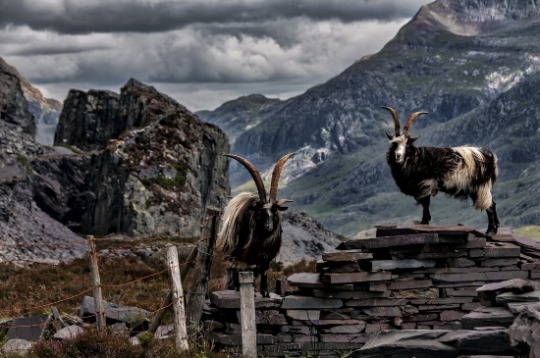
View On WordPress
#dewithon24#CWLT#Dewithon#Horatio Clare#Jon Mlynarski#Reading Wales 2024#Welsh Culture#Welsh Folktales#Welsh Legends#Welsh Myths
0 notes
Text
"In Welsh folklore the Cŵn Annwn, "hounds of Annwn", were the spectral hounds of Annwn, the otherworld of Celtic mythology. According to legend, their growling is loudest when they are at a distance, and as they draw nearer, it grows softer and softer. Their coming is generally seen as a death portent"
I like to think that by the time they catch up with you, they are making very unthreatening meeping noises, and instead of tearing you to pieces, they just boop their noses against your shins. That then instantly teleports you to Annwn. From what I've read, Annwn seems a good place to live. Especially if you're not of nobility. The King of Annwn is quite a charitable person too. So if it was me, I'd be heading out to the hills, desperate for an encounter with the white-coated, red-eared boop squad. Teleport me to Annwn ya little meepers!
#emeraldtext#folklore#mabinogion#cymru#wales#welsh folklore#annwn#otherworld#hounds#legend#myth#folktale
13 notes
·
View notes
Text
I’ve discovered that my college library has a lot of Katharine Briggs books.
I am so incredibly excited I can finally read her books but my mischievous side is coming out.
I am considering writing notes or copying the books on my computer and posting them here on tumblr so the vast majority of the Internet, who don’t have access to this important author, can finally read her.
Let me know in the comments if you want me to do this.
#Katharine Briggs#british folklore#Katharine Mary Briggs#British folk tales#encyclopedia of fairies#a dictionary of fairies#nine lives: the folklore of cats#the folklore of the Cotswolds#folktales of England#forgotten folk tales of the English counties#British witchcraft#pagan#celtic witch#welsh witch#paganism#witchcraft
3 notes
·
View notes
Note

HELLO HYRULE HIGHLAND GAMES JUST DROPPED
YEEEEEEEEEE LETS GOOO
#ye legacy link is scottish inspired#and autumn also to an extent ajskd#maggie takes some inspiration from welsh fae folktales#theres this one vid in particular of a welsh professor with the most beautiful soft gentle voice that fits mags perfectly in my head#and when I saw Autumn to an extent its cause his dad isnt actually hylian#he was a bit of an adventurer himself and an immigrant from a country inspired by denmark#gosh my friend has an Irish inspired Link story too theyre actually turning into a novel and i love it a lot but like yeeeee#*holds them all gently*
4 notes
·
View notes
Text
Jack-o'-lanterns have such a grab bag of lore, i love it
Fire, of course, has a long history of offering protection from evil forces. During the Celtic festival of Samhain (from which many Halloween traditions originate), the veil between worlds was considered thin, and ritual bonfires reminded the spooks to stay on their side of the lane.
Many a lantern has protected the lonely traveler on a dark moonless night. But lanterns can be dangerous too—especially the supernatural ones. in certain folklore 'jack-o'-lantern' was another name for will-o'-the-wisps, atmospheric ghost lights (or as legend has it, lost souls) that appear above bogs and lure unwise wanderers into sinkholes.
Then there's the 18th cent Irish folktale of Stingy Jack, a mischievous fellow who tricked the Devil twice, exacting a promise that hell would never claim his soul. So Jack goes on his cheerful way, and dies (as humans are prone to do), and ends up at the pearly gates. Now Heaven, it turns out, doesn't want a damn thing to do with him. So Jack jaunts on down and goes knocking on the gates of hell—only to have Satan slam the door in his face! How this leads to Stingy Jack being doomed to wander the earth carrying a hollowed out rutabaga lit by an ember of the flames of hell, I couldn't tell you. But that is how the story goes.
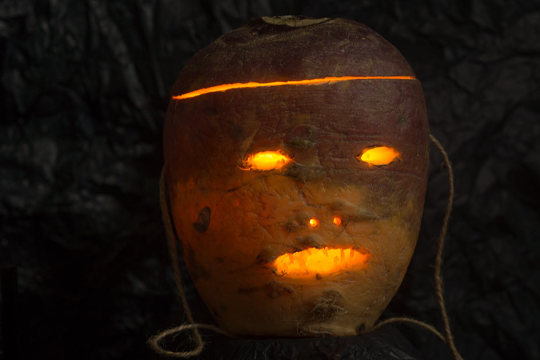
Whether the legend of Stingy Jack inspired or fueled or was created-by the gourd-carving practice, by the 19th cent, Irish, Scottish, and Welsh alike were annually carving jack-o'-lanterns out of turnips & rutabaga & beets & potatoes, and lighting them up to ward off Jack and other wandering spirits. Immigrants carried the tradition to North America, where pumpkins were indigenous and much easier to carve.
And so the modern Jack-o'-Lantern was born!

Not that gourd lanterns were anything new. Metalwork was expensive, after all, and gourds worked as-well-as and better-than-most crops when it came to carving a poor farmer's lantern.
As for carving human faces into vegetables, that supposedly goes back thousands of years in certain Celtic cultures. It may even have evolved from head veneration, or been used to represent the severed skulls of enemies defeated in battle. Or maybe not! Like many human traditions, jack-o'-lanterns evolved over multiple eras and cultures and regions, in some ways we can trace and others we can only guess at. But at the end of the day, it makes a damn good story, and a spooky way to celebrate—which is as good a reason as any (and a better reason than most!) to keep a tradition going.
In conclusion: happy spooky season, and remind me to tell yall about plastered human skulls one of these days 🎃
srcs 1, 2, 3
2K notes
·
View notes
Note
what “mushroom trick” are you talking about?
Jacky's mom became pregnant with her when she ate a mushroom from a faerie ring. Jacky doesn't actually have a biological dad.
It's based on a welsh folktale (folk belief?). The ring had special criteria I haven't settled on yet or people would be popping babies all the time, but if Jacky wants a kid she could try it.
Her kind of faerie also imprints, so if a dad were in the picture, like Herman, the baby would probably grow up looking a little like him.
102 notes
·
View notes
Text

The Tangi [Scottish, Shetland folklore]
There are lots of folktales about supernatural horses that live underwater and entice people into mounting them. Once the victim does so, they find themselves unable to dismount and the horse takes its prey underwater to drown them. The most famous of these creatures are the Scottish Kelpie and the Welsh Ceffyl Dŵr, though there are lots of similar aquatic horse monsters from British, Germanic and Scandinavian folktales. They are related and come from the same root story.
In the Shetland Islands, however, there are two such creatures, and while they are undeniably similar, surprisingly they are said to be two distinct kinds of beings that exist in different habitats. The Njuggel (or ‘Shoopiltee’ in Northern Shetland, among other names) resides in lakes and other fresh bodies of water, whereas the Tangi (also Tangie) is a marine monster. Keep in mind however that this distinction is not set in stone (folklore is hardly an exact science, of course) and in some places the Njuggel and the Tangi are considered to be synonyms.
In the Orkney islands of northern Scotland, the Tangie would appear either as an old human covered in seaweed (true to its name, as the name ‘Tangie’ is likely derived from ‘tang’ which is a local term for seaweed) or as an aquatic horse. This Tangie would jump out at unwary travelers, and it took a particular liking to young women, kidnapping them from the banks of the Scottish lakes and dragging them into the depths to be devoured.
In places where the two are said to be separate monsters, the following distinction is usually made: a Njuggel appears as a white or grey horse with a wheel for a tail that drowns its victims in lakes. A Tangi, on the other hand, is black or dark grey and has no wheel. Tangis are shapeshifting creatures and sometimes appear as cows, other animals, or as humans. When taking the form of a human, a Tangi usually chooses to appear as a handsome young man and seeks out girls to seduce and have sex with. Sometimes they go the extra mile and abduct a girl to marry her. Being associated with the sea, they commonly haunt shores but these creatures make their homes in seaside caverns.
Like its cousin the Njuggel, a Tangi is engulfed in a blue flame when galloping at high speed. Sailors sometimes claimed to have seen one of these creatures as a distant blue flash that raced across the shore.
One old account of these creatures also claimed that they have wings and the uncanny ability to locate any object that fell or was thrown into the ocean, regardless of depth. These claims are not backed by any other sources. However, they do have an important trait that sets them apart from Kelpies, Njuggels, Nixen and the like.
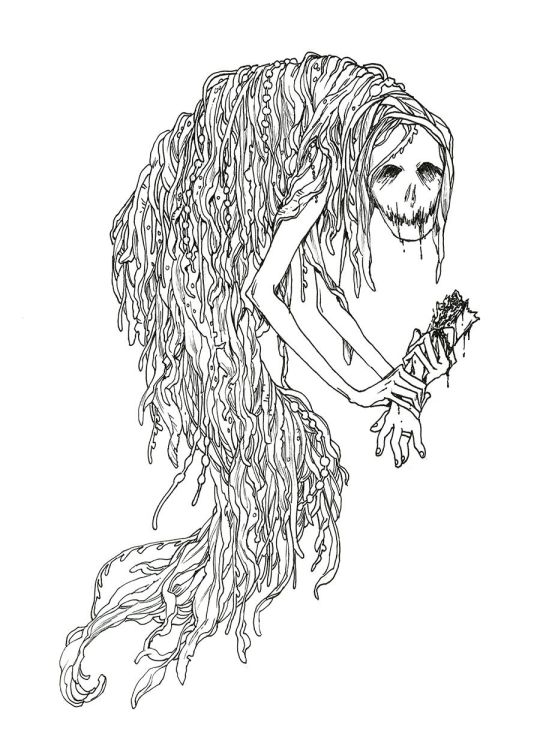
Whereas most Kelpie-like monsters are said to make people mount them and then drown their victims, the Tangi does not need to be mounted. It can cast a spell on its victims by galloping in circles around them. When under the influence of the Tangi’s magic, the victim becomes hypnotized and immediately tries to drown themselves, usually by jumping off a cliff into the ocean. Those who survive find themselves in a dazed state which lasts for a few days at most.
They are not invincible however and share the same weaknesses as the Njuggels: they are afraid of fire, can be injured with iron and lose their power if you utter their name. For example, one story tells of a man who encountered a Tangi. The black horse started running in circles around him but he managed to stab it with an iron knife. The creature ran away and disappeared.
Sources:
Teit, J. A., 1918, Water-beings in Shetlandic Folk-Lore, as Remembered by Shetlanders in British Columbia, The Journal of American Folklore, 31(120), p.180-201.
Lecouteux, C., 2016, Encyclopedia of Norse and Germanic Folklore, Mythology, and Magic.
Monaghan, P., 2004, The Encyclopedia of Celtic Mythology and Folklore, Facts on File Library of Religion and Mythology, 512 pp.
Pérez-Lloréns et al., 2020, Seaweeds in mythology, folklore, poetry and life, Journal of Applied Phycology, 32, 3157-3182.
(image source 1: orig03 on Deviantart. The image actually depicts a black Kelpie, but I figured it’s fine since the Tangi is related and similar)
(image source 2: unknown, sorry)
#Scottish mythology#British mythology#aquatic creatures#monsters#Kelpie#mythical creatures#fey#bestiary
77 notes
·
View notes
Note
Hello! I was wondering if you have any resources on changelings in folklore/history, or even just on fae in general? I've been eyeing fae magic for a few years now and am now thinking of taking up study of the topic in earnest. Love ur blog btw, and can't wait for the book!
I don't work with the Good Neighbors myself and fairy magic isn't my area of expertise, but I do have a few older books of related lore and folktales I can direct you to:
British Goblins, Welsh Folk-lore, Fairy Mythology, Legends and Traditions, by Wirt Sikes (1880)
Fairy and Folk Tales of the Irish Peasantry, Edited and Selected by W. B. Yeats (1888)
Fairy Legends and Traditions of the South of Ireland, by Thomas Crofton Croker (1827)
The Fairy Faith in Celtic Countries, by W.Y. Evans-Wentz (1911)
The Fairy Mythology, by Thomas Keightley (1870)
The Magic of the Middle Ages, by Viktor Rydberg (1865)
The Origins of Popular Superstitions and Customs, by T. Sharper Knowlson (1910)
The Secret Commonwealth of Elves, Fauns and Fairies, by Robert Kirk (written 1691, pub. in print 1893)
West Irish Folk-Tales and Romances, by William Larminie (1893)
All of these titles are in the public domain and should be available for free on sites like Project Gutenberg or Global Grey Ebooks. (There may also be some other titles there that you can use for historical lore reference.)
While they may not be resources for modern versions of fae magic, they definitely provide a lot of background information that was written and published BEFORE the rise of modern witchcraft, which means the authors were just recording the folklore as they found it, rather than trying to bend it into a witchy shape. (It's pretty much invariably viewed through a Christian lens, but one should keep in mind that this is part of the culture of the countries of origin when it comes to fairies and spirits.)
I also have this list of JSTOR articles related to the history of witchcraft, occultism, witch trials, and related folklore - including fairies.
Thanks for tuning in! Hope this helps!
#618foxes#witchblr#witch community#faery magic#fairy lore#book recs#free books#Bree answers your inquiries
86 notes
·
View notes
Text
Doctor Who 2024 series news

New information about the eight episodes in the Doctor Who 2024 series is revealed in SFX magazine 378. We’ve included contextual information from what we know from other sources and filming reports.
Space Babies

This episode picks up from the events that happen at the end of The Church on Ruby Road with Ruby Sunday (Millie Gibson) entering the TARDIS for the first time. The Doctor (Ncuti Gatwa) and Ruby land on a spaceship occupied by babies who are very talkative for their age, a scary slimy monster called the Bogeyman (Robert Strange) — and no adults to be found. Space Babies introduces the series story arc of both the Doctor and Ruby’s foundling mystery.
The Devil's Chord

Ncuti Gatwa describes Maestro (Jinkx Monsoon) as “Such a delicious villain.” The Doctor and Ruby meet and chat with The Beatles in this episode set in 1963. Both Ncuti Gatwa and Millie Gibson will sing in the story. The large recording room at Abbey Road Studios was recreated as a set at Wolf Studios Wales.
Boom

The Doctor and Ruby travel in the TARDIS to Ruby’s first alien planet — a war-torn world. The episode, written by Steven Moffat and described as “intense”, was filmed in chronological order with Ncuti Gatwa receiving praise for his performance from director Julie Anne Robinson.
73 Yards
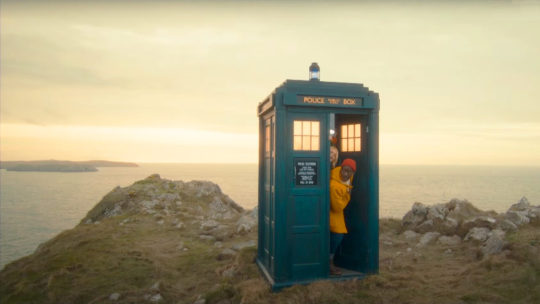
The TARDIS lands on the Welsh coast and Ruby must solve a mystery involving a Welsh horror folktale legend. The TARDIS scenes were genuinely filmed on the Welsh Cost in Pembrokeshire. Dame Siân Phillips co-stars with Aneurin Barnard and Jemma Redgrave. Filming reports reveal that Barnard plays a Welsh candidate named Roger Ap Gwilliam.
Dot and Bubble

Gatwa and Gibson filmed their first Doctor Who scenes together on a pontoon inside entrance locks in Cardiff Bay Barrage for Dot and Bubble. The setting for Dot and Bubble is a colony with an out-of-control dangerous situation on an alien planet. Callie Cooke plays an influential person in the colony. The episode is described as very Black Mirror and touches on a real-world problem which will likely cause a good deal of discussion after the episode airs.
Rogue

This episode was co-written Kate Herron and Briony Redman. Set in the Regency Era in 1813, Rogue, described by Davies as “a proper Bridgerton episode with dances and waltzes”, was filmed in three different manor houses. Psychic earrings allow the Doctor and Ruby to period dance with skill. Jonathan Groff and Indira Varma co-star. Varma plays the villainous Duchess of Pemberton — who is not what she seems.
The Legend of Ruby Sunday and Empire of Death

These episodes, set on Earth, feature UNIT headquarters populated by Kate Stewart (Jemma Redgrave), Mel Bush (Bonnie Langford), Rose Noble (Yasmin Finney), Morris (Lenny Rush) and Colonel Ibrahim (Alexander Devrient). Russell T Davies calls this episode “shocking” and “The Most Devastating Finale.”
Doctor Who, starring Ncuti Gatwa and Millie Gibson returns on 11 May 2024 midnight, 00:00 BST (10 May 7:00pm ET) streaming on BBC iPlayer and Disney+ with Space Babies and The Devil’s Chord. Both episodes will broadcast on BBC One in the UK and Ireland on 11 May immediately before Eurovision. The remaining six episodes will stream at 00:00 BST on the six subsequent Saturdays.
-- So it looks like Jemma DID film with Ncuti, despite what she said in a recent interview. Which is as it should be - she can't be in New Who and NOT appear with the Doctor - that ain't right and proper! AND she's in three episodes this series (that we know of!). Huzzah!
19 notes
·
View notes
Note
I've just finally got around to reading "Stealing the Elf-King's Roses", which I loved. I do have a question - the name of Gelert, is that a Duncton Wood reference, or a coincidence, or is it a reference to something that maybe William Horwood was also referencing? Because every time I see the name in print my mind goes "Gelert, the hound of Siabod", so I'm curious.
The name (possibly coined within the last few centuries) comes from the one given, in the famous Welsh folktale, to the faithful wolfhound of Prince Llywelyn the Great—slain by his master, who thought that the dog running to greet him with bloody jaws had killed his infant child. The hound's jaws, though, were bloody because Gelert had just killed a wolf that was trying to get into the child's cradle. ...In "fable" mode, the tragic story's usually read as a warning against taking action rashly, before all the important details of a situation are known. (A brief prose retelling of the folktale is here. It's also spawned a number of poetic retellings over the last century or two..)
This trope's a common one in worldwide folklore, btw, and has its own category number in the Aarne-Thompson-Uther folklore index—type 178A. Here are some other stories that fall into the category.*
I borrowed the name from the folktale partly as a humorous side-reference to Gel's wolfhound-ish looks. I'm guessing Horwood borrowed it for his character for some similar reason.
HTH!
*Interestingly, a very watered-down version of this trope appears in the DC: League of Superpets movie as part of the backstory of Ace the BatHound.
47 notes
·
View notes
Text
A fantasy read-list: A-2
Fantasy read-list
Part A: Ancient fantasy
2) Mythological fantasy (other mythologies)
Beyond the Greco-Roman mythology, which remained the main source and main influence over European literature for millenia, two other main groups of myths had a huge influence over the later “fantasy” genres.
# On one side, the mythology of Northern Europe (Nordic/Scandinavian, Germanic, but also other ones such as Finnish). When it comes to Norse mythology, two works are the first names that pop-up: the Eddas. Compilations of old legends and mythical poems, they form the main sources of Norse myths. The oldest of the two is the Poetic Edda, or Elder Edda, an ancient compilation of Norse myths and legends in verse. The second Edda is the Prose Edda, so called because it was written in prose by the Icelandic scholar Snorri Sturluson (alternate names being Snorri’s Edda or the Younger Edda). Sorri Sturluson also wrote numerous other works of great importance, such as Heimskringla (a historical saga depicting the dynasties of Norse kings, starting with tales intermingled with Norse mythology, before growing increasingly “historically-accurate”) or the Ynglinga saga - some also attributed to him the Egil’s Saga.
Other “tales of the North” include, of course, Beowulf, one of the oldest English poems of history, and the most famous version of the old Germanic legend of the hero Beowulf ; the Germanic Völsunga saga and Nibelungenlied ; as well as the Kalevala - which is a bit late, I’ll admit, it was compiled in the 19th century, so it is from a very different time than the other works listed here, but it is the most complete and influential attempt at recreating the old Finnish mythology.
# On the other side, the Celtic mythologies. The two most famous are, of course, the Welsh and the Irish mythologies (the third main branch of Celtic religion, the Gaul mythology, was not recorded in texts).
For Welsh mythology, there is one work to go: the Mabinogion. It is one of the most complete collections of Welsh folktales and legends, and the earliest surviving Welsh prose stories - though a late record feeling the influence of Christianization over the late. It is also one of the earliest appearances of the figure of King Arthur, making it part of the “Matter of Britain”, we’ll talk about later.
For Irish mythology, we have much, MUCH more texts, but hopefully they were already sorted in “series” forming the various “cycles” of Irish mythologies. In order we have: The Mythological Cycle, or Cycle of the Gods. The Book of Invasions, the Battle of Moytura, the Children of Lir and the Wooing of Etain. The Ulster Cycle, mostly told through the epic The Cattle-Raid of Cooley. The Fianna Cycle, or Fenian Cycle, whose most important work would be Tales of the Elders of Ireland. And finally the Kings’ Cycle, with the famous trilogy of The Madness of Suibhne, The Feast of Dun na nGed, and The Battle of Mag Rath.
Another famous Irish tale not part of these old mythological cycles, but still defining the early/medieval Irish literature is The Voyage of Bran.
# While the trio of Greco-Roman, Nordic (Norse/Germanic) and Celtic mythologies were the most influential over the “fantasy literature” as a we know it today, other mythologies should be talked about - due to them either having temporary influences over the history of “supernatural literature” (such as through specific “fashions”), having smaller influences over fantasy works, or being used today to renew the fantasy genre.
The Vedas form the oldest religious texts of Hinduism, and the oldest texts of Sanskrit literature. They are the four sacred books of the early Hinduist religion: the Rigveda, the Yajurveda, the Samaveda and the Atharvaveda. What is very interesting is that the Vedas are tied to what is called the “Vedic Hinduism”, an ancient, old form of Hinduism, which was centered around a pantheon of deities not too dissimilar to the pantheons of the Greeks, Norse or Celts - the Vedas reflect the form of Hinduist religion and mythology that was still close to its “Indo-European” mythology roots, a “cousin religion” to those of European Antiquity. Afterward, there was a big change in Hinduism, leading to the rise of a new form of the religion (usually called Puranic if my memory serves me well), this time focused on the famous trinity of deities we know today: Brahma, Vishnu and Shiva.
The classic epics and supernatural novels of China have been a source of inspiration for more Asian-influenced fantasy genres. Heavily influenced and shaped by the various mythologies and religions co-existing in China, they include: the Epic of Darkness, the Investiture of the Gods, Strange Tales from a Chinese Studio, or What the Master does not Speak of - as well as the most famous of them all, THE great epic of China, Journey to the West. If you want less fictionized, more ancient sources, of course the “Five Classics” of Confucianism should be talked about: Classic of Poetry, Book of Documents, Book of Rites, Book of Changes, as well as Spring and Autumn Annals (though the Classic of Poetry and Book of Documents would be the more interesting one, as they contain more mythological texts and subtones - the Book of Changes is about a divination system, the Book of Rites about religious rites and courtly customs, and the Annals is a historical record). And, of course, let’s not forget to mention the “Four Great Folktales” of China: the Legend of the White Snake, the Butterfly Lovers, the Cowherd and the Weaver Girl, as well as Lady Meng Jiang.
# As for Japanese mythology, there are three main sources of information that form the main corpus of legends and stories of Japan. The Kojiki (Record of Ancient Matters), a chronicle in which numerous myths, legends and folktales are collected, and which is considered the oldest literary work of Japan ; the Nihon Shoki, which is one of the oldest chronicles of the history of Japan, and thus a mostly historical document, but which begins with the Japanese creation myths and several Japanese legends found or modified from the Kojiki ; and finally the Fudoki, which are a series of reports of the 8th century that collected the various oral traditions and local legends of each of the Japanese provinces.
# The Mesopotamian mythologies are another group not to be ignored, as they form the oldest piece of literature of history! The legends of Sumer, Akkadia and Babylon can be summed up in a handful of epics and sacred texts - the first of all epics!. You have the three “rival” creation myths: the Atra-Hasis epic for the Akkadians, the Eridu Genesis for the Sumerians and the Enuma Elish story for the Babylonians. And to these three creation myths you should had the two hero-epics of Mesopotamian literature: on one side the story of Adapa and the South Wind, on the other the one and only, most famous of all tales, the Epic of Gilgamesh.
# And of course, this read-list must include... The Bible. Beyond the numerous mythologies of Antiquity with their polytheistic pantheons and complex set of legends, there is one book that is at the root of the European imagination and has influenced so deeply European culture it is intertwined with it... The Bible. European literary works are imbued with Judeo-Christianity, and as such fantasy works are also deeply reflective of Judeo-Christian themes, legends, motifs and characters. So you have on one side the Ancient Testament, the part of the Bible that the Christians have in common with the Jews (though in Judaism the Ancient Testament is called the “Torah”) - the most famous and influential parts of the Ancient Testament/Torah being the first two books, Genesis (the creation myth) and Exodus (the legend of Moses). And on the other side you have the exclusively Christian part of the Bible, the New Testament - with its two most influential parts being the Gospels (the four canonical records of the life of Jesus, the Christ) and The Book of Revelation (the one people tend to know by its flashier name... The Apocalypse).
#read-list#fantasy#fantasy read-list#mythology#mythologies#celtic mythology#norse mythology#japanese mythology#chinese mythology#mesopotamian mythology#books#references#book references#sources
37 notes
·
View notes
Photo
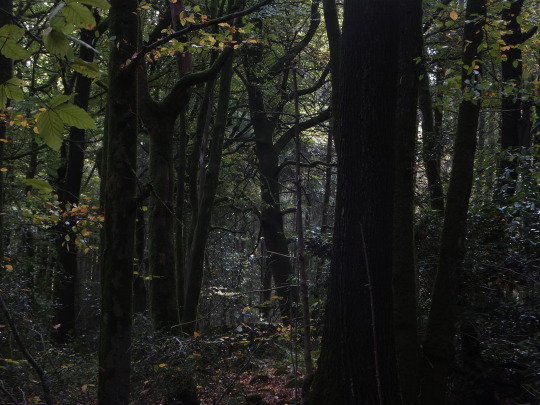
Ninewells Wood
#own photo#forest#woods#trees#autumn#november#wales#wye valley#english-welsh border#nature#dark nature#leaves#fairytale#folktale#lensblr#orignal photography#nature photography
121 notes
·
View notes
Photo

MYSTICAL MARI LWYD One of a kind dual headed Mari Lwyd in celestial gown with leather ears, sun and moon, beaded details, hand embroidered spiral and handpainted faces. www.xphaiea.bigcartel.com ••• #xphaiea #marilwyd #welsh #wales #welshfolklore #folkcustom #witchesofinstagram #folklore #britishfolklore #witch #witches #esoteric #occult #pagansofinstagram #magic #mythandlegend #artdoll #artdolls #ooak #goblincore #fantasy #horse #horseskull #folktales https://www.instagram.com/p/Cnml2mXrR67/?igshid=NGJjMDIxMWI=
#xphaiea#marilwyd#welsh#wales#welshfolklore#folkcustom#witchesofinstagram#folklore#britishfolklore#witch#witches#esoteric#occult#pagansofinstagram#magic#mythandlegend#artdoll#artdolls#ooak#goblincore#fantasy#horse#horseskull#folktales
63 notes
·
View notes
Text
No Beast So Fierce (8090 words) by A_Farnese
Chapters: 2/?
Fandom: Merlin (TV)
Rating: Teen And Up Audiences
Warnings: No Archive Warnings Apply
Characters: Arthur Pendragon (Merlin), Morgana (Merlin), Gwen (Merlin), Leon (Merlin), Merlin (Merlin), Morgause (Merlin)
Additional Tags: Alternate Universe - Historical, Historical Fantasy, 14th Century, Period-Typical Language, Period-Typical Religion, Dark Merlin (Merlin)
Summary:
England, 1375.
It has been a quarter of a century since Edward III died in the great plague and Uther Pendragon brought an army out of Wales to claim the English throne. In a time of relative peace, Prince Arthur has been searching the Welsh woods for a shadowy sorcerer who might be nothing more than a folktale. As Christmas approaches, though, Arthur is summoned back to court where the dangers are more than mere shadows in the forest.
5 notes
·
View notes
Text
March 2024 Diverse Reads

March 2024 Diverse Reads:
•”The Great Divide” by Cristina Henriquez, March 05, Ecco Press, Literary/Historical/Sagas/Hispanic & Latino
•”Anita de Monte Laughs Last” by Xochitl Gonzalez, March 05, Flatiron Books, Literary/Historical/Coming of Age/Hispanic & Latino/Multiple Timeliness
•”Thunder Song: Essays” by Sasha Lapointe, March 05, Counterpoint, Essays, Anthropology/ Ethnic Studies/Indigenous Studies/Popular Culture/Cultural, Ethnic & Regional/Native American & Aboriginal
•”James” by Percival Everett, March 19, Doubleday Books, Literary/Historical/Satire
•”Parasol Against the Axe” by Helen Oyeyemi, March 05, Riverhead Books, Literary/Magical Realism/Friendship
•”36 Ways of Writing a Vietnamese Poem” by Nam Le, March 05, Knopf Publishing Group, Poetry, Asian American/European/English, Irish, Scottish, Welsh
•The Moon That Turns You Back: Poems” by Hala Alyan, March 12, Ecco Press, Poetry, Middle Eastern/Family/Places
•”Ward Toward: Volume 118” by Cindy Juyoung Ok, March 05, Yale University Press, Poetry/Asian/Women/Spaces/Mental Health/Hospitalization/Cultural & Social Themes
•”There's Always This Year: On Basketball and Ascension” by Hanif Abdurraqib, March 26, Random House, Personal Memoir/Ethnic Studies/African American Studies/Basketball
•”You Get What You Pay for: Essays” by Morgan Parker, March 12, One World, Essays/Ethnic Studies/African American Studies/Cultural, Ethnic & Regional/African American & Black
•”Pride and Joy” by Louisa Onomé, March 12, Atria Books, Contemporary/Women/Family Life/African American
•”Like Happiness” by Ursula Villarreal-Moura, March 26, Celadon Books, Literary/Coming of Age/Feminist/LGBT/Hispanic & Latino
•”Memory Piece” by Lisa Ko, March 19, Riverhead Books, Literary/Women/Asian American
•”The Angel of Indian Lake” by Stephen Graham Jones, March 26, S&S/Saga Press, Horror/Thriller/Suspense/Native American & Aboriginal
•”Women of Good Fortune” by Sophie Wan, March 05, Graydon House, ContemporaryWomen/Crime/Friendship/Feminist/World Literature/Asia/China
•”Victim” by Andrew Boryga, March 12, Doubleday Books, Literary/Satire/Humorous/Black Humor
•”The Emperor and the Endless Palace” by Justinian Huang, March 26, Mira Books, Historical/Fantasy/Folk Tales, Legends & Mythology/Romance/LGBT/Asian American/Cultural Heritage
•”Until August” by Gabriel García Márquez & Anne McLean (Translator), March 12, Knopf Publishing Group, Literary/Women/Family Life/Marriage & Divorce
•”A A Year of Last Things: Poems” by Michael Ondaatje, March 19, Knopf Publishing Group, Poetry/Death, Grief, Loss/Love & Erotica/America/World Heritage
•”Green Frog: Stories” Gina Chung, March 12, Knopf Publishing Group, Short Stories/Family Life/Folktales/Fantasy/American/Korean American
Happy reading!
Monica ✌️
#books#bookworm#bookish#bibliophile#book lover#bookaddict#reading#book#booklr#bookaholic#books & libraries#reading list#to read#reader#reading recommendations#diverse books#diverse reads#read diversely#bookblr#booklover#books and libraries#books and reading
3 notes
·
View notes
Text
Folk Practitioner Survey Results
We had a total of 87 people take part in this survey, so thanks to all of you who submitted your responses! I won't be posting every single response to every question, because that would be way too much to fit here. Instead, I will show the charts available and mention the responses to questions that stood out/weren't repetitive.
Written responses will be quoted, and if I have any commentary to add it will be noted with an ➳ arrow.
The first question was asking about the person's general age, which resulted in the following:

The second question asked about what the individual practices, which resulted in the following:

The third question was optional, specifically catered to those who selected the "other" option. We got a variety of results from this, but to simplify it, the following folk practices were mentioned in those results: Welsh, Filipino, Caribbean, Cornish, Hoodoo, Australian, Brujeria, Jewish, Romani, Hungarian, Transylvanian, Brazilian, Dutch, Western American, Japanese, Finnish, Dutch, French, Scandinavian, Polish, Jeiwsh, Midwestern American and Lithuanian.
The fourth question asked about their ancestors homelands and where the individual came from themselves. Specifically, if they came from the region their folk practices originated from or their ancestors. This resulted in the following:

The fifth question was optional, specifically catered to those who selected the "no" option. We asked why did they choose the folk practices they follow. There weren't many responses that weren't repetitive, but I'll post this one so you can get an idea on what most people said:
"For the Slavic practice, neither myself nor my ancestors came from the region - however it has been calling to me since I was young and their stories and cultures have reached me in my soul. I do my best to not involve myself in ancestry or cultural rites I haven't been invited into, but some I have as I've traveled through the Balkans"
The sixth question asked if the individual was a generational practitioner, reconnecting, mentored or learning by themselves. This resulted in the following:

The seventh question was optional, catering to those who selected the "Not generational; I am learning by myself currently" option. It simply asks how are they learning, which resulted in responses such as the following:
"Mainly by reading books about Appalachian folk magic and following tumblr pages about it"
"Research through as many mediums as I can get my hands on. Academic histories, biographies, other practitioners online, podcasts. I try to cast my net as wide as I can so I have multiple sources that I can contrast and compare."
"books, science articles, personal experience, journaling, cause and effect"
"I have books of Scottish folktales that I try to sieve for info, I have a website full of folktales. I'm looking into witchcraft books written in/about Scotland."
"Not being mentored by any one person re: Appalachian/Ozark magic, but given general guidance and advice by a number of practitioners in the region. Self taught for the rest."
"Somewhere between reconnecting and taught. Took much of my practice from observation of my relatives but I was missing key pieces so I'm going through family accounts and works written by other folk practioners in the region to fill in the gaps."
"Online resources and folklore books mostly"
"Reading. Translating when I have the energy to do so."
"I am learning through research, talking with other folk practitioners from the same areas, and asking other people from my country/region about stories/superstitions!"
"Good ol' internet sleuthing (including JSTOR documents), repudated books, folk witch covenmates on discord, podcasts by authors I like"
➳ A small note I'd like to add; I myself do not believe people can truly learn the folk practices directly related to specific regions without speaking to generational practitioners/folk practitioners native to those regions, but I do applaud many of these people for digging up old books and translating them.
The eighth question asked why the individual chose their folk practices. These were some of the results:
"Other forms of work just didn't work for me, then came the realization that what my Granny did when I was little was a type of magic and I dove headfirst into it."
"It’s a part of my culture and religion. My parents taught it to me and it makes me feel connected to my heritage and my family."
"The adaptable nature and the instinct of it, I grew up with many of the practices just labeled under superstitions instead of magic."
"It's comforting and familiar, it makes the most sense in my head."
"I feel like I resonate with it more. Forgive me, but it's not as hippy-dippy as some of the other magic crafts I have seen. It comes from a place of ancestry and history."
"I’m not a fan of any new age stuff…I remember almost being turned away from magic because i thought it was all love and light with a bunch of yoga teachers….until a brilliant folk witch swept me off my feet and put me in the right direction."
"Truthfully it's the path of least resistance. It makes sense to me in a way that learning other systems never did. It gives me connection to my ancestors when as a queer person that relationship was fraught."
"Folk magic has established traditions that are still highly adaptable"
"To connect with my past and my ancestors. Although I am not white, I grew up in a very white environment, which was rather isolating."
"I find it comforting and it brings me meaning."
The ninth question asked if the individual believed their folk practices are closed, semi-closed or open. This is a topic that tends to be debated a lot, and unfortunately I can't narrow down the results much more than this, so here is the chart:

The tenth question asked to explain their reasoning for the previous question, but I failed to require people to include what folk practices they were speaking on in this question so I'm going to skip over this one.
Many of the responses summed up to "It's open, because if you feel called to it that should be enough" or "It's semi-closed because although many traditions are open, you should be living on the land it's from/learning from generational practitioners/much of it is oral tradition". Those who selected "closed" were dominantly bipoc individuals who were speaking on hoodoo, brujeria and things of that nature.
The eleventh question asked everybody to select the religion (or lack of) they followed. These were the results:

The twelfth question asked if religion (or lack of) impacted the individual's practice in any way. These were some of the responses:
"Yes. I incorporate the worship of God into my practices"
"No it doesn't. I keep my religion and my practice very separate due to quite a bit of Christianity related trauma."
"They are intertwined! The christian part anyway. I keep my pagan practices separate."
"I've definitely had to make compromises with a few spirits because of my personal beliefs but we cool"
"Yeah i struggle a lot with how religion fits into my practice as i am From primarily Christian areas. It’s something i am still working through"
"Yes, Christianity is very tied to Appalachian folk magic but I’m not longer Christian so sometimes it can be hard to balance being atheist with the strong Christian traditions of the practice."
"I identify as pagan and often times struggle to make folk practices which are heavily influenced by Christianity fit my deities and what I want to work with."
"A lot of folk magic is intertwined with Christianity. I'm not over the moon about it, but I understand why. I'm trying to see if it makes a difference if you separate out the Christianity versus leaving it in."
"Raised culturally Christian but Norse pagan now, but am attempting to incorporate certain Christian beliefs (saints, novenas, etc) into my own practice, since a lot of the texts/sources we have are from after the conversion of Scandinavia."
"Not particularly. I keep things separate."
And, finally, the last question simply asked if anybody had anything to add onto their submission for the survey. Here are a few responses that stood out to me:
"If you hear whistling in the woods at night no you didn't :)"
"I enjoyed answering these questions. It has brought some things up in my mind that I need to contemplate for a while. Thank you for that."
"I can’t stand witchcraft social media spaces. Incredible levels of disrespect done against all cultures and practices, meanings and definitions change and become more trendy than sincere. I can’t be a part of a community like that."
"I'm not very articulate and I'm certianly afraid of this coming across the wrong way, but I think there's too much infighting in different esoteric communities when half the time we're doing silly little spells and charms and yes, religion and spirituality are deeply personal and powerful subjects, but the fun in it came from me when I thought how ridiculous it is that my grandma on my dad's side knew mustard seed in a necklace would give me good luck and a wish, or that my baba knew that crosses on the window panes that she traced with fingers dipped in olive oil would keep the house safe. None of these things mean anything except that they mean everything."
"Trans rights"
"Personally, I think we lost something when folk magic began to go on the decline. Throughout all human history magic has been there. Now we have new age people and such. lmao"
"Even if you only just moved to a place, immediately research it's folk traditions cuz they're yours now, too. Chances are as a newcomer you prolly have something new to bring to the potluck as well. Just cite your sources, always."
Thanks to everybody who took part in this survey! I got a lot more responses than I initially expected. I was expecting no more than 30, maybe 40 tops. Yet there were 87. Y'all had me shook lol
98 notes
·
View notes